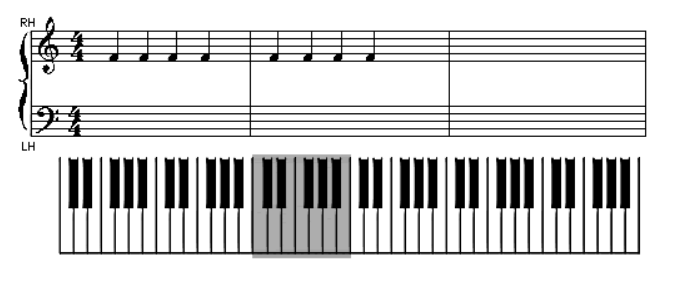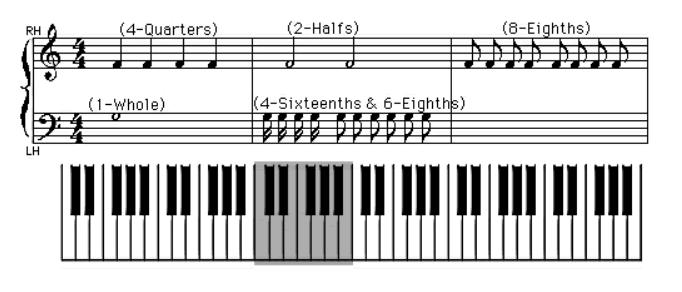Fractions and Time Signature
The 4/4 actually represents a fraction. Four quarters (fourths) added together equal 1. Let’s look at some examples below.
* 1 = 1 (1 whole note equals one measure).
* 1/2+1/2 = 1 (2 half notes added together equal one measure).
* 1/4+1/4+1/4+1/4 = 1 (4 quarter notes added together equal one measure).
* 1/8+1/8+1/8+1/8+1/8+1/8+1/8+1/8 = 1 (8 eighth notes added together equal one measure).
* 1/16+1/16+1/16+1/16+1/8+1/8+1/4+1/4 = 1 (4 sixteenth notes, 2 eighth notes, and 2 quarter notes added together equal one measure).
As you can see, any combination of fractions that equals one is fine.
One last thing to learn . . .
The fraction (4/4) that you see at the beginning of the treble or bass clefs is called the Time Signature.
When I ask you to refer to the Time Signature in future lessons, you will now know to look at the fraction at the beginning of either clef.
In future lessons we will also learn about Key Signatures. Both of these signatures will tell you the important information you will need to know to play any song.
That’s about it for this lesson. Give yourself a great hug for getting this far. You now have all the tools you need to read and play music.
In the next lessons we will put the tools to work. Let’s review the tools you have now.
Review
* Melodic Names (including sharps and flats) of the notes on the Keyboard.
* Melodic Names (including sharps and flats) of the notes on the Staff.
* Rhythmic Names of the notes on the Staff (quarter, eighth, sixteenth, half, and whole).
* The length (size or time signature) of a measure and how to figure it.
* Treble Clef (to be played by your right hand).
* Bass Clef (to be played by your left hand).
Before you go, in lessons to come you will need a music note book with blank staffs in it. You will be writing musical notes in it. You can purchase this at any music store that sells sheet music or you can
download this PDF from here and print it. If you choose this option, please make 8 copies and staple them together into a book for yourself.
While you are printing and assembling your book, I thought you might enjoy listening to my daughter Courtney Sedgwick singing a Christmas arrangement I did for “What Child Is This.”



